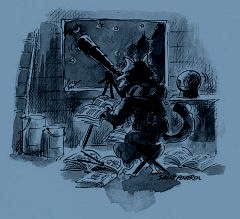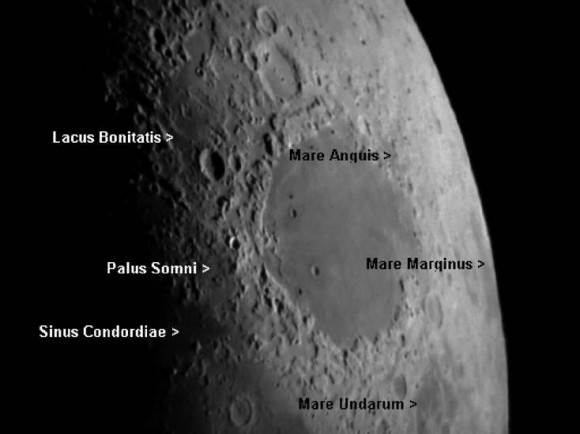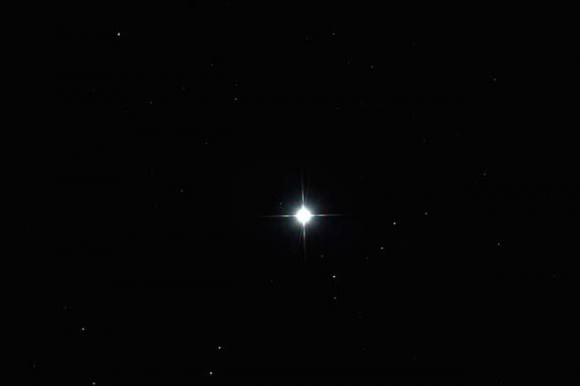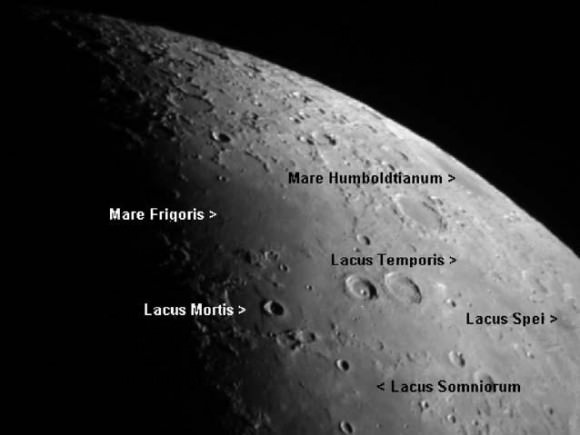Greetings, fellow SkyWatchers! The Moon is back again, but what a terrific target for winter studies. Why not get out your binoculars and telescopes as we take a look at strange and unusual places like the Serpent Sea, the Marsh of Sleep and the Lakes of Time, Death and Dreams? If you haven’t wished upon a star lately, then there’s a serious reason to take a look at Sirius this weekend! Step outside in the dark with me where we’ll explore a little history, a little mystery, and just plain have us some fun…
Friday, January 30, 2009 – Tonight’s early evening Moon is high enough to warrant study. During the last lunar cycle, we reviewed maria large enough to be seen unaided, but many more can be revealed telescopically. Magnify the Crisium region and let’s look around. Along the eastern side near the lunar limb is Mare Marginis, whose position between the nearside and farside will never allow us to see more than a thin gray line. Thanks to the lunar orbiters, we know it has an irregular border and shallow lava fill, which lead scientists to believe Marginus wasn’t created from an impact. Located southeast is Mare Undarum , the ‘‘Sea of Waves.’’ This highly elevated part of the Crisium basin is about the size of Massachusetts, and it probably filled with lava around the time of the Imbrium impact. Northeast, and separated by a mountain range, is Mare Anguis, or the ‘‘Serpent Sea.’’ This Vermont-sized area of lunar landscape formed differently and may be home to a vast number of lava tubes.
Now look to Crisium’s northwest for a new feature, Lacus Bonitatis , or the ‘‘Lake of Goodness.’’ With features similar to those of maria, this small, irregularly shaped area has as much ‘‘coastline’’ as the Black Sea! Further south is Palus Somni, the ‘‘Marsh of Sleep.’’ This curious feature is an upland area. Relatively flat—but very uneven—its high albedo (surface reflectivity) makes it a rewarding study. Last on tonight’s tour is Sinus Concordiae , the ‘‘Bay of Harmony.’’ Essentially part of the maria that spawned it, this inlet leads toward higher ground. Concordiae’s small bay is roughly the size of Pedro Bank in Jamaica. Like its earthly counterpart, it may have mountain peaks that are just barely covered – but by lava flow, not seawater. Be sure to list your evening’s observations in your lunar notes. We’ll return in the months ahead here for more!
‘‘Everything has a natural explanation. The moon is not a god, but a great rock.’’ — Anaxagoras (475 BC)
 Saturday, January 31, 2009 – What a busy date in astronomy history! In 1958 the United States. launched its first satellite – Explorer 1 – which discovered the bands of radiation now referred to as the Van Allen Belts . In 1961 the Mercury-Redstone 2 launched, carrying Ham the chimpanzee to fame. Cabin pressure failed during the suborbital flight, but inside his pressure suit, Ham remained safe and performed his tasks with a reaction time only a half second slower than on the ground, proving primates could function in space! (And a few years later, astronauts started drinking and shooting at each other, proving that humans could function like primates.) Ham lived for another 17 years, and the celebrated chimp gave many performances – even guest starring in movies!
Saturday, January 31, 2009 – What a busy date in astronomy history! In 1958 the United States. launched its first satellite – Explorer 1 – which discovered the bands of radiation now referred to as the Van Allen Belts . In 1961 the Mercury-Redstone 2 launched, carrying Ham the chimpanzee to fame. Cabin pressure failed during the suborbital flight, but inside his pressure suit, Ham remained safe and performed his tasks with a reaction time only a half second slower than on the ground, proving primates could function in space! (And a few years later, astronauts started drinking and shooting at each other, proving that humans could function like primates.) Ham lived for another 17 years, and the celebrated chimp gave many performances – even guest starring in movies!
Luna 9 was launched in 1962 and 72 hours after its launch became the first craft to successfully touch down on the Moon and broadcast television from Oceanus Procellarum . Even Apollo 14 was Luna-bound today in 1971! Alvan Graham Clark , Jr, made history at the eyepiece on this date in 1862. While watching Sirius and testing an 18″ refractor his family built, Clark uncovered the intense star’s faint companion – Sirius B. Friedrich Bessel had proposed its existence back in 1844, but this was the first visual confirmation.
Try your own hand at the ‘‘Scorching One.’’ Alpha Canis Majoris has an amazing magnitude of -1.42. Next to Alpha Centauri , 8.7 light-year distant Sirius is the closest visual star, but it’s not standing still. Part of the Ursa Major moving stream, Sirius has changed position by one and half times the apparent width of the Moon in just 2,000 years! Telescopically, this main-sequence gem is dazzling white, tinged with blue and diffracts a rainbow of colors. For many of us, beautiful iridescence is all we’ll ever see, but a small telescope (114-150mm) under perfectly steady skies will reveal the secretive companion. In 20 years it will reach maximum separation of 11.500, so keep watching to Sirius’ southeast when you observe – perhaps you’ll spot B!
 Sunday, February 1, 2009 – On this day we celebrate the 1905 birth of Lloyd Berkner, the first person to measure Earth’s ionosphere. His work with radar led to an understanding of radio wave propagation. He also served as administrator at Green Bank National Radio Astronomy Observatory. For his achievements in space science, NASA awarded Berkner the Distinguished Public Service Medal.
Sunday, February 1, 2009 – On this day we celebrate the 1905 birth of Lloyd Berkner, the first person to measure Earth’s ionosphere. His work with radar led to an understanding of radio wave propagation. He also served as administrator at Green Bank National Radio Astronomy Observatory. For his achievements in space science, NASA awarded Berkner the Distinguished Public Service Medal.
The broad crescent Moon dominates the early evening sky. Tonight we’ll explore new features as we start in the lunar north with Mare Humboldtianum spanning 350 kilometers, this inconspicuous multi-ringed feature depends on libration for best views.
Further south along the limb is Lacus Spei (the Lake of Hope), a diminutive feature so small it could be crossed at walking speed in 10 hours! West of Humboldtianum and Spei is a pair of lighter areas devoid of features— Lacus Temporis (the Lake of Time). These two small overlapping basins were filled by the same lava flow, thus forming this small mare. How long to walk across Temporis? Twice as much ‘‘Time’’ as ‘‘Hope’’!
Relocate Mare Frigoris (the Cold Sea) and look south along the terminator for Lacus Mortis (the Lake of Death) and its counterpart Lacus Somniorum (the Lake of Dreams). Is there a connection here? You betcha! These two basin areas were filled from a basaltic flow, which might have united them, but a small mountain range kept them apart.
‘‘There is something haunting in the light of the Moon; it has all the dispassionateness of a disembodied soul, and something of its inconceivable mystery.’’ –Joseph Conrad
By the way, we believe Werner Heisenberg died on this day in 1976, but no one is certain.
Until next week? Ask for the Moon… But keep on reaching for the stars!
This week’s awesome images are: The Crisium Region (credit—Greg Konkel), Ham
the Chimpanzee (credit—NASA), Sirius (credit—John Chumack), Lloyd Berkner (public image) and Hope, Time, Death, and Dreams (credit—Greg Konkel). We thank you so much for sharing your splendid talents with us!





Mare Marginis IS listed as an impact basin, one of the oldest, in some lunar reviews. See Wilhelms, The geologic history of the Moon, 1987, and Petro and Pieters, J. Geophys. Res., 2004.
very kewl! that’s one of the beauties of getting information out there… learning from others!
thanks for updating me, donald!
The names given to lunar features by various observers are sheer poetry, as haunting as anything by H. P. Lovecraft or Edgar Allen Poe. Thanks for the tour, Tammy — your articles are always very much appreciated. 🙂
I’ve been searching tonight, but can’t find anything. When I looked towards the moon tonight, there is a HUGE star that’s every bit as bright as the moon itself. Is this a planet?
Hi Martha,
I guess you must have seen Venus the brightest of the planets at – 4.7 mag at its best. It will get as close as 1 degree from the crescent Moon next month.